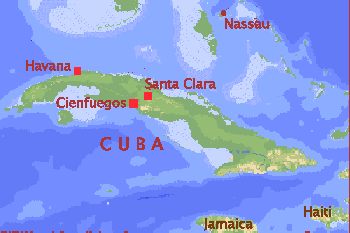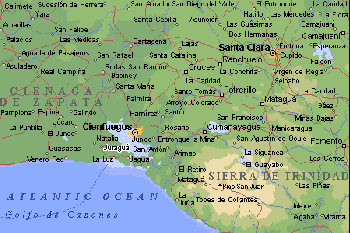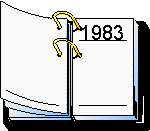| Maps of Cuba and Juragua
|
|
 |
 |
|
|
|
History of the Cuban Commercial Nuclear Program
| It is possible to describe
the Cuban Nuclear Program without once mentioning the United States, but
it may be more comprehensible to an American audience to compare and contrast
it with the energy trends in this country. Cuba is only 90 miles from U.S.
territory, but there are immense political and economic differences. Juragua's
reactors have contributed to some of these differences but, ironically,
Juragua's history also reflects some of the similarities.
Cuba and the United States
have substantially different economic structures, but they are both dependent
on foreign oil. More than half of the oil used in the United States comes
from abroad. Although U.S. crude oil imports are more than 70 times the
level imported by Cuba, the impact of supply interruptions is more severe
on that island, where an estimated 80 to 90 percent of Cuba’s petroleum
supply comes from other nations. In both Cuba and the United States, oil
crises in the 1970's would lead to nuclear construction in the 1980's.
Cuba had fewer options. Bagasse, the fiber remaining when sugar is squeezed from cane, is used by Cuba to produce fuel. Bagasse, however, is also needed for cattle feed and for papermaking. Cuba’s domestic oil reserves are scant, so increasing domestic production was not feasible. Simultaneously, both countries pursued the nuclear option-but the results were vastly different. In 1970, there were only 18 operable commercial nuclear generators in the entire United States and none in Cuba. By America's bicentennial, 1976, the U.S. total had tripled. That same year, the Soviet Union agreed to supply two nuclear generating units for Cuba's first nuclear plant. The site selected for the Juragua Nuclear Station is near Cienfuegos, a city on the south coast. Both critics and proponents found significance in the city’s name. Depending on point-of-view, Cienfuegos symbolizes the power or the problems the reactors could unleash. The city’s name translates as “a hundred fires.” |
||||||||||||
| Maps of Cuba and Juragua
|
|
 |
 |
|
|
|
Timeline

In 1983, ATOMENERGOEXPORT, the Soviet-owned nuclear company, began work
on Cuba's two pressurized light water reactors(PWRs). Identical models,
either unit has a net capacity of 408 net megawatts (electric). To encourage
an export market, the Soviets incorporated new safety features.
It has taken seven years to progress from the signing of the initial
Cuban/Soviet agreement to the start of construction in 1983, but the international
outlook for nuclear power throughout the period seemed excellent, and prospects
continued to improve. By 1985, annual nuclear generation reached record
levels in Canada, the United States, Argentina, Brazil, Belgium, Finland,
France, Germany, Italy, the Netherlands, Spain, Switzerland, the United
Kingdom, India, Japan, South Korea, and Taiwan. U.S. nuclear generation
had quadrupled since the oil embargo of 1973. During the same period, nuclear
output had increased eight-fold in western Europe and ten-fold in Asia.
The prospects for 1986 looked even better than for 1985. The Soviets planned to bring new units on-line in 1986. In August, Britain's Calder Hall unit 1 would complete its 30th year of service. The 17 countries that established nuclear generation records in 1985 expected to match or surpass them in 1986. For the Italian nuclear industry, 1986 would bring a milestone: it was to be the best year in the industry's history. Good news had almost become routine by April 1986. Palo Verde 2 came on-line in Arizona that month. It joined Palo Verde 1 as the largest commercial nuclear reactors in the United States. France's Paluel 4 also came on-line in April. It tied Paluel 1, 2, and 3 as the largest reactor ever built up to that time. Before the month was over, the encouraging news about Paluel 4 and Palo Verde 2 was eclipsed. On the morning of April 26th, a Ukrainian unit went off-line, permanently.
Explosion and fire destroyed the number 4 reactor at the Chernobyl Nuclear
Power Station. The accident aroused public concern worldwide about nuclear
safety, especially, the safety of Soviet-designed reactors. Although the
reactor type was different, the accident that occurred at Chernobyl, thousands
of miles away, almost doomed the Juragua project.
In Italy, which has no Soviet reactors, the reaction was immediate. In November of 1987, Italian citizens voted in favor of a nuclear moratorium. After generating a record 8.7 billion kilowatthours in 1986, Italian reactors shut down. Twelve years later, they remain shut down. No vote was taken in Cuba, but the event did not go unnoticed. International pressure on Cuba to end its nuclear program increased. Whatever criticisms may be leveled against Juragua reactors, the Cuban reactors have almost nothing in common with Chernobyl 4 or any of its companions. The designs differ, the procedures differ, the materials used in construction differ, the conditions under which they were built differ, their strengths and weaknesses differ, and the extent of international cooperation on nuclear technology and safety has greatly improved since the accident at Chernobyl. Eight months after the fire at Chernobyl 4, the Soviet Union brought two new reactors on line: Kalinin 2 in Russia and Zaporozhe 3 in the Ukraine, both PWR designs that are quite different from the RBMK designs at Chernobyl. Even at Chernobyl, units 1, 2, and 3 were returned to service. Two of these units were still operational in 1997. Chernobyl 4, however, was a turning point for Juragua. Increasingly,
Cuba had to rely on its own resources and resourcefulness. Cuban perseverance
and ingenuity were enough to keep the project going five more years, but
Russian technology and money (the resources essential for completing it)
were less available. The immediate consequences were delay. The long-term
consequences are still being pondered today.
By August 1991, Cuba's overall subsidy from the USSR was cut significantly
to U.S. $3 billion. Estimates of the cut range from one-third to one-half
of the annual subsidy. In early November 1991, the Russian Federation's
Minister of Foreign Economic Relations announced the decision to suspend
financing for the nuclear project. Cuba's total debt to Russia was estimated
at $25 billion.
If everything had gone according to plan, 1993 would have been an especially significant year for Juragua. This was the target year for Juragua's unit 1 to begin generating Cuba's first nuclear electricity. As 1992 drew to a close, the only certainty about Juragua's future was that the target date would not be met. But 1993 did provide some encouraging news for Cuba. In November 1993,
Cuban and Russian officials signed a trade agreement in Moscow. Predictions
of Cuban economic recovery followed the signing. The U.S. Nuclear Regulatory
Commission (NRC) noted that the predictions were predicated (at least in
part) on Unit 1 at Juragua being operational by 1995. The NRC estimated
Unit 1 could save "approximately 1 million tons of petroleum used to produce
electricity annually, and would be expected to generate 12 percent of the
island's consumption of electrical energy."
On July 20, 1995, NBC News broadcasts a segment on the Juragua plant.
The Reactor Director, Isaac Alayon Gutierrez, stated during the broadcast
that (translated) “during the construction period, we incorporated several
international requirements for safety.” Mr. Gutierrez believes U.S. concerns
are groundless and that international experts are of the same opinion.
According to the report, Cuba believes the reactor will be on line by 1999.
On October 3, 1996, the Prensa Latina news agency reports that the explosion
of a generator ignited a blaze at Tallapiedra, an oil-fired power plant.
Whether the cause was sabotage, wear and tear on aging machinery, carelessness,
or other, it emphasized the vulnerability of Cuba’s electricity supply.
Cuba was already experiencing random blackouts due to fuel shortages. Following
the incident, wide sections of Havana were forced to endure periodic blackouts.
After Tallapiedra, those who advocate nuclear power were able to claim
that a drop in oil prices is not necessarily a panacea for Cuba’s aging
utilities. On January 17, 1997, Cuban President Fidel Castro announced postponement
of the project due to lack of resources. He cited failure to attract a
third party to finance $750 million needed to complete Juragua 1. The U.
S. Congress took an active role in discouraging investors by passing the
Helms-Burton Act, which contained the following warning:
In February 1997, representatives of the U.S. General Accounting Office
met with the Vice Minister, Ministry of the Russian Federation for Atomic
Energy. The Vice Minister stated that Russia plans to resume work on the
Juragua project in 1998. In the meantime, Russia extended through the end
of 1997 a $30 million line of credit for Cuba to mothball the plant.
|
||||